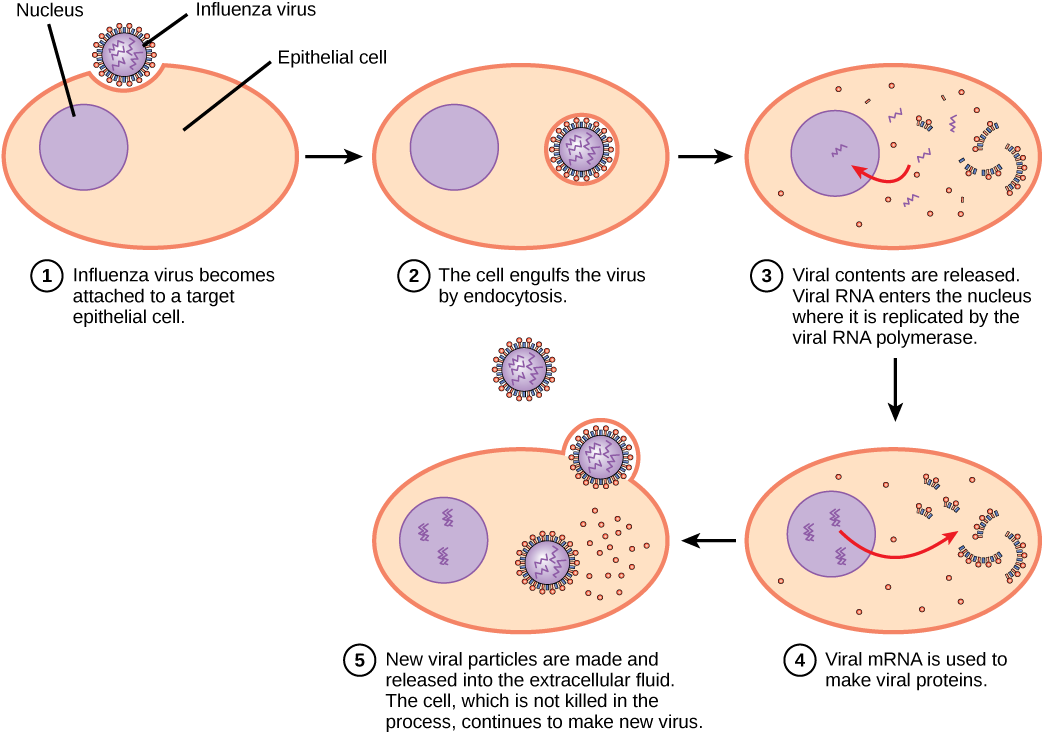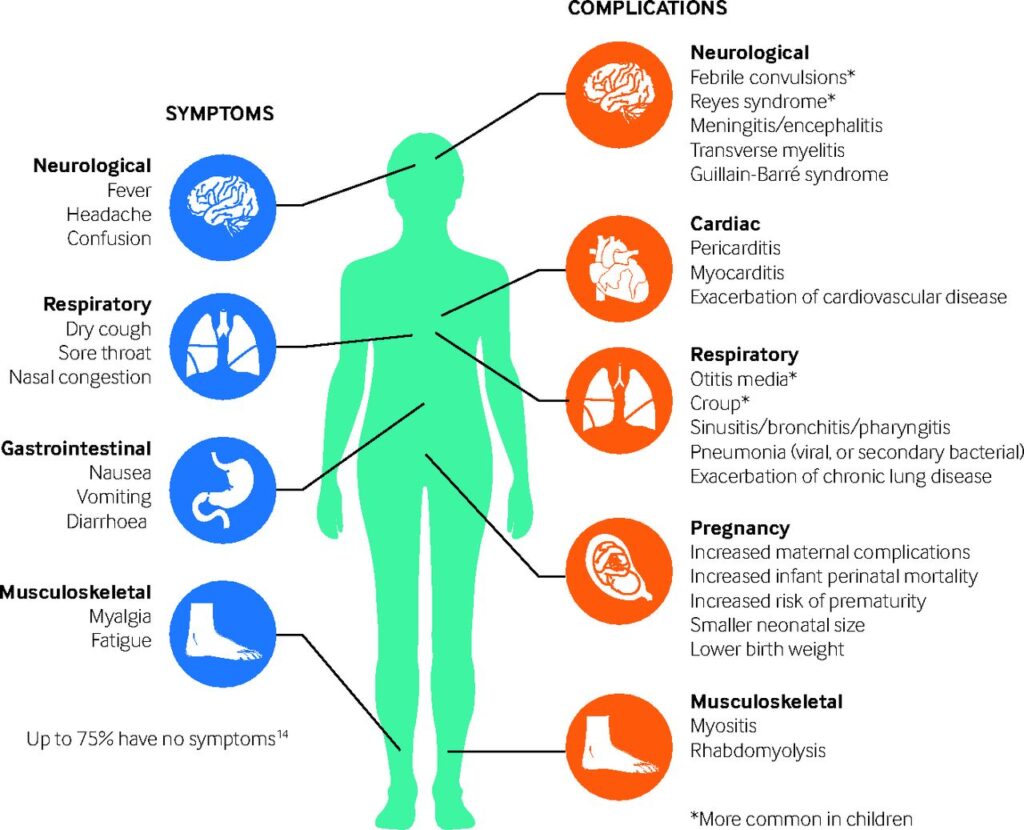Influenza, commonly referred to as the flu, is a contagious respiratory illness caused by viruses that infect the nose, throat, and sometimes the lungs. The flu can range from mild to severe and, in some cases, lead to hospitalization or even death. Understanding what influenza is, how it spreads, its symptoms, and ways to prevent it is crucial for maintaining good health. In this article, we will explore these aspects in detail.

What Is Influenza?
Influenza is an infectious disease caused by influenza viruses. These viruses belong to the Orthomyxoviridae family and are classified into four main types: A, B, C, and D. Among these, types A and B are responsible for seasonal flu outbreaks in humans. Type A viruses are further divided into subtypes based on two proteins found on their surface: hemagglutinin and neuraminidase. This classification system helps scientists track changes in the virus and develop vaccines each year.
Influenza viruses are constantly evolving through processes called antigenic drift and antigenic shift. Antigenic drift involves small genetic changes that occur over time, while antigenic shift refers to major changes resulting from the mixing of genes between different strains. These changes make it challenging to control the spread of influenza and necessitate annual updates to flu vaccines.
The Impact of Influenza
- Influenza affects millions of people worldwide every year.
- It leads to significant economic losses due to missed workdays and medical expenses.
- Vulnerable populations, such as young children, elderly individuals, pregnant women, and those with chronic health conditions, face higher risks of complications.
How Does Influenza Spread?
Influenza primarily spreads through respiratory droplets when an infected person talks, coughs, or sneezes. These droplets can land in the mouths or noses of nearby individuals or be inhaled into the lungs. Additionally, touching surfaces contaminated with the virus and then touching one’s mouth, nose, or eyes can also lead to infection.
Factors That Facilitate Transmission
- Crowded environments like schools, offices, and public transportation increase the likelihood of transmission.
- Poor ventilation in indoor spaces allows viral particles to linger longer in the air.
- Close contact with infected individuals, especially during peak flu season, raises the risk of exposure.
Incubation Period and Contagiousness
The incubation period for influenza typically ranges from one to four days after exposure. An infected individual can begin spreading the virus about one day before symptoms appear and remain contagious for up to five to seven days after becoming ill. Children and those with weakened immune systems may be contagious for an extended period.
Symptoms of Influenza
The symptoms of influenza often develop suddenly and can vary in severity. Common signs include fever, chills, muscle aches, fatigue, cough, sore throat, runny or stuffy nose, headaches, and sometimes gastrointestinal issues like nausea or vomiting (more common in children).
Distinguishing Between Flu and Cold
| Symptom | Flu | Cold |
|---|---|---|
| Fever | Common, high-grade | Rare, low-grade |
| Body Aches | Severe | Mild |
| Fatigue | Extreme | Mild |
| Cough | Common, dry | Mild to moderate |
Complications Associated With Influenza
While most people recover from the flu within a week or two, certain groups are at higher risk of developing serious complications. These include pneumonia, bronchitis, sinus infections, ear infections, and worsening of pre-existing medical conditions such as asthma, diabetes, or heart disease. Prompt medical attention is essential if symptoms worsen or persist beyond the typical recovery period.
Prevention Strategies for Influenza
Preventing influenza requires a combination of personal hygiene practices, vaccination, and community efforts. By adopting preventive measures, individuals can reduce their chances of contracting and spreading the virus.
Vaccination: The First Line of Defense
Annual vaccination remains the most effective way to protect against influenza. Each year, researchers analyze global data to predict which strains will circulate during the upcoming flu season and update the vaccine accordingly. Receiving the flu shot not only reduces the risk of illness but also minimizes the severity of symptoms if infection occurs.
Who Should Get Vaccinated?
- Everyone aged six months and older should receive the flu vaccine annually.
- High-risk groups, including pregnant women, young children, older adults, and individuals with chronic health conditions, are strongly encouraged to get vaccinated.
- Healthcare workers and caregivers should prioritize vaccination to safeguard themselves and vulnerable patients.
Practicing Good Hygiene
Simple yet effective hygiene habits play a critical role in preventing the spread of influenza. Regular handwashing with soap and water for at least twenty seconds removes germs from hands and reduces the risk of transmission. If soap and water are unavailable, alcohol-based hand sanitizers can serve as an alternative.
Additional Hygiene Tips
- Avoid close contact with sick individuals.
- Cover your mouth and nose with a tissue or elbow when coughing or sneezing.
- Dispose of used tissues immediately and wash hands afterward.
- Clean and disinfect frequently touched objects and surfaces regularly.
Healthy Lifestyle Choices
Maintaining overall health strengthens the immune system and enhances the body’s ability to fight off infections. Adequate sleep, balanced nutrition, regular physical activity, stress management, and staying hydrated contribute to better resilience against illnesses like influenza.
Boosting Immunity Naturally
- Consume a diet rich in fruits, vegetables, whole grains, lean proteins, and healthy fats.
- Exercise moderately for at least thirty minutes a day, five days a week.
- Practice relaxation techniques such as meditation, yoga, or deep breathing exercises.
- Avoid smoking and excessive alcohol consumption, as they weaken the immune system.
Community Efforts to Combat Influenza
Beyond individual actions, communities must collaborate to minimize the impact of influenza. Public health campaigns, workplace policies, and educational initiatives all contribute to raising awareness and promoting preventive behaviors.
Role of Schools and Workplaces
Schools and workplaces are key settings where influenza can spread rapidly. Implementing policies that encourage sick employees and students to stay home until fully recovered helps curb transmission. Providing access to hand sanitizers, tissues, and cleaning supplies fosters a healthier environment.
Public Health Interventions
- Governments and organizations distribute free or subsidized flu vaccines to underserved populations.
- Educational programs teach proper hygiene practices and emphasize the importance of vaccination.
- Surveillance systems monitor flu activity and provide timely updates to guide response efforts.
Global Collaboration Against Influenza
Influenza knows no borders, making international cooperation vital for addressing outbreaks effectively. Sharing research findings, coordinating vaccine production, and supporting resource-limited countries strengthen global preparedness and response capabilities.





